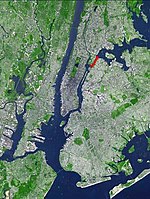Astoria Park

Astoria Park is a 59.96-acre (24.26 ha) public park in the Astoria neighborhood of Queens in New York City. The park is situated on the eastern shore of the Hell Gate, a strait of the East River, between Ditmars Boulevard to the north and Hoyt Avenue to the south. The Robert F. Kennedy (Triborough) and Hell Gate Bridges respectively pass over the park's southern and northern sections. Astoria Park contains a playground, a soccer field, a running track, a skate park, and courts for tennis, basketball, and bocce. Astoria Park also includes the Astoria Play Center, which consists of a recreation center and a pool. The park and play center are maintained by the New York City Department of Parks and Recreation (NYC Parks). While Astoria Park was planned in 1905, the land was not acquired until October 1913. Astoria Park was formally named after the surrounding neighborhood in December 1913 and recreational facilities gradually opened within the park over the two following decades. The pool and bathhouse were designed by John Hatton during a Works Progress Administration project in 1935–1936 and was used for the United States Olympic Trials for swimming during 1936, 1952, and 1964. The park was extensively renovated in the 1980s and the late 2010s. The Astoria Play Center was designated a city landmark by the New York City Landmarks Preservation Commission in 2007.
Excerpt from the Wikipedia article Astoria Park (License: CC BY-SA 3.0, Authors, Images).Astoria Park
Shore Boulevard, New York Queens
Geographical coordinates (GPS) Address Nearby Places Show on map
Geographical coordinates (GPS)
| Latitude | Longitude |
|---|---|
| N 40.779444444444 ° | E -73.921944444444 ° |
Address
Astoria Play Center and Swimming Pool
Shore Boulevard
11102 New York, Queens
New York, United States
Open on Google Maps









